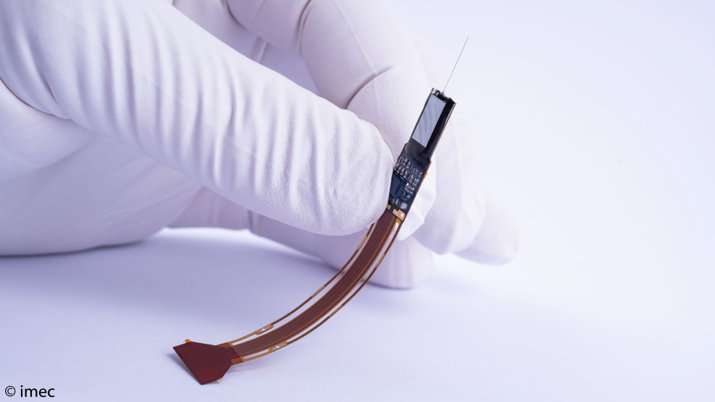Neuropixels technology ready for release

A transformative technology for detecting and recording neural activity in the brain is now available for researchers to purchase through imec, a leading nanoelectronics research center in Belgium.
Neuropixels, a new neural-recording technology that lets scientists simultaneously monitor hundreds of neurons throughout an animal's brain, is now being made available for purchase by the research community.
The technology vastly improves upon previous methods of detecting and recording neural activity in the brains of living animals, says Tim Harris, a senior fellow at the Howard Hughes Medical Institute (HHMI)'s Janelia Research Campus and leader of the Neuropixels collaboration. Researchers can now collect "more data – as good as they have ever taken – and it's easier to obtain than before," he says.
That could make it easier for researchers to learn how cells and circuits in the brain work together to process information, he adds.
The release of Neuropixels follows five years of development supported by a $5.5 million investment from HHMI, the Allen Institute for Brain Science, the Gatsby Charitable Foundation, and the Wellcome Trust. Several million dollars more were contributed by the Allen Institute, Wellcome, and HHMI to support testing, refinement, and specification.
Probing the brain
Neuropixels probes, thin silicon slivers about 10 millimeters long, are equipped with 960 electrodes to detect electrical activity in the brain. Because they are about the same length as a mouse's brain, theycan collect data from many brain regions at once. The probes are densely packed with electrodes, making it easier for researchers to pinpoint the cellular sources of the brain's signals than they could with earlier technologies. Additionally, each Neuropixels probe incorporates its own recording system, reducing the output wires to a single pair and keeping the necessary hardware compact.
When the Neuropixels project began in 2013, the electrophysiology probes available to most labs had, at most, 64 sensors. Researchers could measure the activity of individual neurons within a specific spot in the brain or detect patterns of regional activity, but they could not do both at the same time. HHMI and its collaborators knew that the technological leap needed by the neuroscience community would require millions of dollars and fabrication capabilities well beyond that of an academic institution – so they came together to fund the high-risk project.
Matt Jones, a neuroscientist whose lab at the University of Bristol in the United Kingdom tested Neuropixels during the development process, says the new probes have transformed researchers' chances of cracking the neural code. His team used to painstakingly position recording tools in a few regions of rats' brains to record the activity of a few dozen neurons, monitoring the cells over hours as the animals learned and slept.
"This approach is slow, but it worked," he says. "And then Neuropixels arrived." Now, Jones and his team routinely record from more than 600 neurons at a time, monitoring cells distributed over a wide swath of the brain over multiple days.
Ready for order
Imec, a nanoelectronics research center in Leuven, Belgium where Neuropixels' prototypes were developed and manufactured, is producing the probes and is the sole source of distribution to the research community. Imec will begin making the probes available on October 31, 2018. Researchers can request the probes, which are priced at 1,200 Euros, at www.neuropixels.org or www.neuropixels.info.
Six hundred probes are now ready to be distributed, and at least 2,400 more will be produced in 2019. Labs that place orders for 20 or more probes before November 30, 2018, will be entered into a lottery system for immediate fulfillment. Ship dates will be determined by lottery, with the first 30 selected (for orders of 20 probes or more) in 2018, and the remainder for 2019 (minimum order of five probes). If demand for Neuropixels probes remains high, production rates may increase late next year, Harris says.
Since the earliest stages of development, the Neuropixels team has been committed to supplying the new probes to as many labs as possible at the lowest possible cost. To keep users' costs down, training and technical support for the devices will be provided by labs around the world whose researchers worked with prototype models during their development.


















